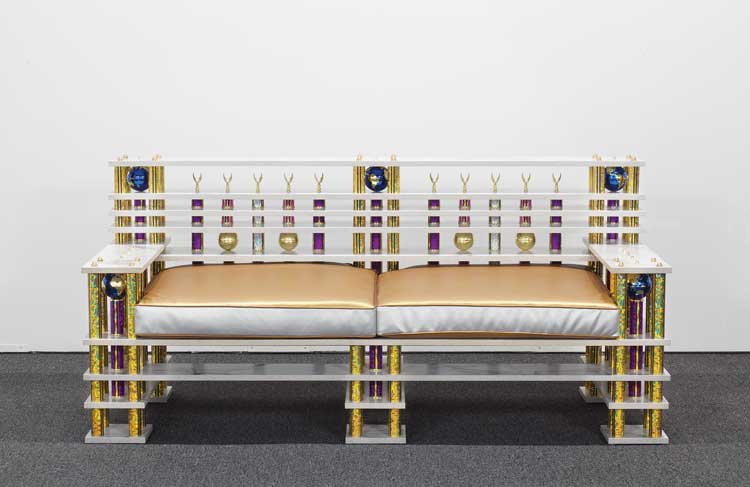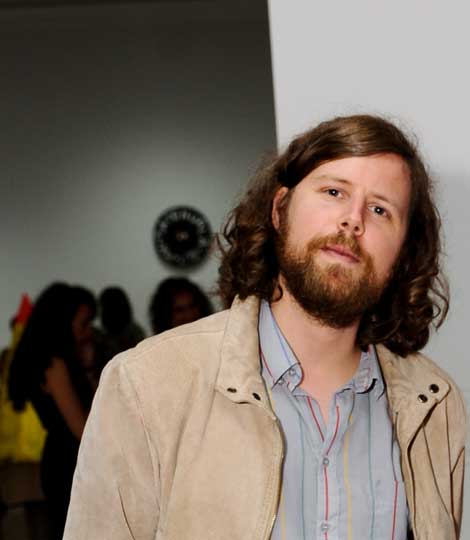Ry Rocklen saved oyster shells, along with some rocks, then tried to unload them one day at a garage sale. “I didn’t sell a thing,“ he told me in an interview, about his boyhood collecting obsession. Decades later, he is still drawn to treasuring odd stuff: discarded junk, mail order trophy parts, even his own used clothing. Valuing their material qualities and cultural currency, he assembles them into sculptures. Often they have embellished surfaces, with a recurring motif being a tiled or checkerboard pattern.
Rocklen began his career in the late 2000s with grungy domestic items turned into works of stunning beauty: saggy mattresses covered with iridescent bathroom tiles, a mattress as a “reverse bed of nails” (Refuge, 2007)—which he loosely refers to as “sequins” for their dazzling visual effect—copper- and nickel-plated folded bed sheets (Cover to Cover, 2010), a tattered patio umbrella emerging from the seat of a wooden chair (Umbrella, 2009). His first solo show out of grad school at Black Dragon Society took place at a fortuitous moment, as LA’s Chinatown reached a zenith in popularity as a destination gallery row and the city was emerging as an art world center.
I asked Rocklen—who was born and raised here and is a graduate of UCLA and USC—about the influence of place. He described a common local experience key to his art. “When it comes to stuff laying by the side of the road, LA’s such a perfect place for it, since there’s room for things to sit around for a while in unclaimed territory.” He speculated that conditions aren’t as conducive in other cities. Perhaps because most finds are household objects, he turns that into a guiding principle. “I have the general criteria that whatever it is should be fairly ubiquitous, like a bed or a chair or a table.” His website is telling, with works categorized according to quotidian experiences: sit, sleep, shelter, wardrobe, décor.
Another constant is his wry (he might say “Ry”) wit, clearly apparent in his works’ titles, which are usually puns. Subtle humor creeps into the actual sculptures too—not as irony, but as a genuine celebration of the absurdity in his found objects’ transformations. This lighthearted sensibility is nevertheless grounded in some serious art history. The switch from useful to useless, non-art to art, is by now a sacred tradition, rooted in the iconic touchstones of Dada and Surrealist readymades and Rauschenburg combines.

Ry Rocklen, Breadth Deep, 2012, installation at LA Municipal Art Gallery for “Made in LA.” Photo by Lee Thompson.
Like other contemporary LA artists, Rocklen draws from the city’s rich history of assemblage art, but also more broadly, of sculpture as a discipline. He considers Charles Ray, his undergraduate professor at UCLA, a great influence. “Through working with Charlie I was shown the potential of sculpture at a really fundamental level. I remember him talking about how seeing a work, you could have a sensation. How the choice of materials affects perception; an understanding of weight.” As Rocklen said this, I recalled the strangely visceral experience I had when viewing a particular work—the copper- and nickel-plated folded bed sheets—on his website. Without ever having seen the real thing, I “felt” the comfortable texture and weight of fabric switched out by something much heavier and colder.
Rocklen continued. “Some of the potency is an innate or instinctual familiarity.” Of found objects, he said, “These things are used habitually, like a curtain being drawn everyday, or a chair being sat on. There’s a sense of labor by its former user.” For his installation at the Hammer Museum’s first “Made in LA” exhibition, he created floor tiles from thrift store paintings. By doing so, he co-opted somebody else’s relationship to them. He thinks about this, too, when occasionally enlisting help. While making Refuge, he invited friends to drop nails into a mesh screen. “That’s part of the appeal, the intensity of production; the energy in service of this aesthetic marvel.” He attributes this acquired-labor approach to Mike Kelley’s For All the Love Hours Lost, the late artist’s stuffed-animal hybrids with their patina of wear.
A recent Rocklen piece, Second to None (2011) functions similarly, consisting of found objects—trophies—bereft of their original owners. Thinking of them as once prized and now lonely anthropomorphic stand-ins for human endeavor and passion, they share with Kelley’s tossed-aside toys an intentionally pathetic vibe. Visually, though, Rocklen’s stacked paeans to achievement remind me of Chris Burden’s Urban Light, LACMA’s outdoor assembly of vintage street lamps, for their formal, comparative arrangements.
Within the last few years, Rocklen has made fewer found-object sculptures and seems to be taking a radically different turn. Instead of collecting worn out consumer goods and heightening their uniqueness, he is doing the opposite: referencing the used or customized as a point of departure and mass-producing that. He is currently casting his entire wardrobe in porcelain. “I’m treating myself as a found object,” he said. The day I visited the studio, a number of molds and casts were in various states of production. It was fascinating to make out the textures of folded clothing in the hard, bone-white material and realize—just as with detritus dragged off the street—that I could discern subtleties of use. One shirt was threadbare, another brand new.
Last year he began developing a line of furniture, “Trophy Modern,” made from trophy parts. The found trophies of Second to None had led to a full-on obsession, as he thought about how they were originally put together. Shiny new parts are now mail-ordered and used as components in tables and chairs. They have also found their way into fabricated chess sets. “Like a version of Legos, it’s about creating a system and adhering to it.”
What appeals to Rocklen about this new turn in his work is that the primary purpose is not art. “It is to be sat on or used as a coffee table or as a liner for a shower, which doesn’t make it any less important.” This made sense to me until he said: “It doesn’t matter if it’s art or not.” Was he implying that he was simply going to do what he wanted to anyway? I can’t help but think that when an artist creates something, it is automatically art, the functional aspect being moot or at least secondary.
This summer Rocklen performed a rap session at LACMA’s bookstore in conjunction with the unveiling of an edition of 10 chess sets. Trophy parts make up the pieces, with basketball players for the kings and queens, crosses for bishops, jockeys for knights, school graduates for rooks and basketballs for pawns. Thinking of the checkerboard surfaces reminds me of Marcel Duchamp’s obsession with the game. For a while he even gave up art for it. We can only imagine the quintessential Dada artist—champion of the readymade—thrilled at the sight of a Ry Rocklen Trophy Modern Chess Set.





